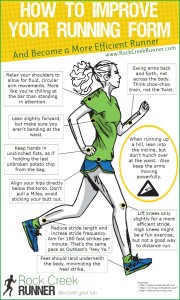Proper arm carriage: are you doing it right?
Running coaches will always tell you that proper running form or at least the most comfortable running position you can make is essential to be an efficient runner. From foot strike to knee drive, there is an endless debate which technique is the best. One running fundamental that receives less attention, though, is arm carriage. Which begs the question: are you carrying your arms correctly?
You may be asking why arm carriage is an important part of training. The answer is efficiency. For those who run longer distances- 21K to ultra-marathon, fatigue is your worst enemy. When a runner is in the threshold of being tired, what can save him is using that extra energy efficiently and your form actually takes care of that.
Recent study shows that how a runner carries his or her arms throughout the race plays a vital role not only on the finish time, but also on how much effort they will need to reach a particular distance. Experts agree that as much as possible, the runner’s posture must be slightly leaning forward so that most of the body parts (especially the limbs) can be used to exert a forward motion.
Swinging your arms is the right way
The Journal of Experimental Biology released a study where they tested runners to run the traditional swinging of the arms vs. three other unconventional form- running with their arms on their head, across their chest and behind their back. The researchers found out that this unnatural running form can is inefficient both in metabolic and biomechanical sense.
(Video Credit: Bobby McGee/ Youtube)
The whole point of carrying your arms correctly is to ensure that they are not dead weight, but can be used to keep you moving forward. It may look baduy to some, but for those who are serious on upgrading to longer distances or having faster paces proper arm carriage is very important. The right arm carriage is also vital when taking on uphills and downhills where the upper body can be used as a critical driving force. That is why, some coaches also recommend that runners do cross fit exercises to develop overall body strength.
Carrying your arms correctly
Good arm carriage means that when you run you hold your arms so that the thumbs simply brush by below your hipbones as you take on each step. As much as possible it should not cross past up your midline of your body. This invisible line travels from your nose down to your navel. The secret to this is keeping your hips still when you are running.
(Video Credit: The Hall Steps Foundation/ Youtube)
Sprinters are also following this form, but they are stricter. For most of them, there is an imaginary line just below their ears which their arms should not cross. This form actually gives you more power in terms of pushing your body forward. It also ensures that you are not wasting precious energy through unnecessary twisting and side-to-side motion.
Practicing proper arm carriage
Getting the proper arm carriage takes time and a lot of practice. First off you want to know how you carry your arms. Have a friend take a video of you running and simply replay and take note of your posture. Practice on swinging your arms and letting your thumbs brush by your hipbone. However, your body may eventually revert back to its former habits in a manner of minutes. This is where muscle memory is necessary that is why you need to redo it until you can manage to hold the posture longer.
(Infographic Credit: Rock Creek Runner)
Also, your arms should not be stiff but loose so that it can move more naturally. However, it should not be too loose that they flop. Your fist should also not be clenched and you can just let your thumbs on your fingers. The best way to do this is imagining that you are carrying a pen in your hand.
Lastly, there are also arguments that some of the world’s top runners have a weird running posture (arm carriage included) that is very unorthodox. The counter point there is- they are a very special case and what works for them may generally not apply to the public at large. If you feel that your current running form is not suitable for you, then keep experimenting until you find it or you can ask a running coach for him to make recommendations and corrections. On the other hand, if you are content with your running form (i.e. it does not cause you any injury and gives you the pace you want)- why fix it?

